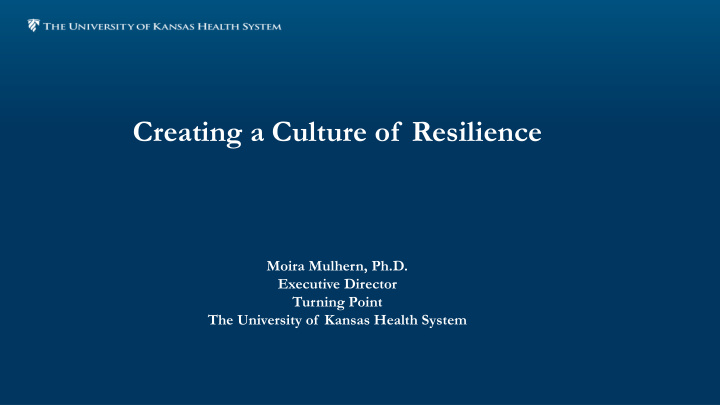



Creating a Culture of Resilience Moira Mulhern, Ph.D. Executive Director Turning Point The University of Kansas Health System
Resilience in Healthcare Analysis includes 300 participants. The Personal Style Inventory measures the three core styles of dealing with stress which are known to underlie resilience. The mean total scores and the scores for all three of the subscales improved by a statistically significant level (p < 0.05) for participants after taking The Resilient Employee.
PROMIS Global Distress
What is Your Culture? • Top down – the leaders set the tone • Key thought-leaders, influencers, management and all staff • Agreed upon vocabulary and mindset • How do you reinforce the language and practice? 11/15/19 5
A System that Adopts a Culture of Resilience can expect: • Lower turnover • Decrease of absenteeism and presenteeism • Improved physical and mental health • Stronger teamwork and less conflict and drama • Stronger, self-defined leaders 11/15/19 6
Ability to Self-Calm • Anxiety runs through the herd – so does calmness • Can you own your own anxiety/stress and not take on the anxiety/stress of others? • Can you get calm? • Can you stay calm? • Do you need others to be calm for you to be calm? • Do you need to remove yourself to get calm? • Practice, practice, practice • Address Stress in the Moment it Triggers • Brief Relaxation Techniques 11/15/19 7
Physical Self-Care • Selecting a mode of exercise • Exercise affects mood, energy and makes you smarter • Nutrition • Stress, sleep and lack of sleep 11/15/19 8
Ability to Self-Replenish • Recovery Time • How full is your bucket? • What fills your bucket? • What depletes your bucket? • The roles you play • Developing Self Replenishment Routines at work 11/15/19 9
Emotional Expressiveness • Can you identify your emotions? • Physiology of emotions • Thinking and feeling – our brain reflects the life we’ve led • Do you know what pushes your buttons? • Situations, Options, Consequences • Other Emotional Processing Facts • Changing Your Brain 11/15/19 10
Techniques to Manage and Calm Emotions 1. Stay calm, step out, stay in 2. Quick Coherence Technique: • Slow breath rate to 5-7 breaths per minute • Daydream about people, places, or activities that you love and appreciate • Do this for 3-5 minutes several times per day 3. Moving emotions: • Slow breath rate to 5-7 breaths per minute • Name the emotion you are feeling • Imagine it right in front of you • Inhale, and as you exhale, repeat “ease” to yourself as you imagine it melting away. 11/15/19 11
Hardiness • Commitment – can you stay involved and not sink into detachment and alienation? • Control – can you turn difficult situations into advantages and not sink into powerlessness or passivity? • Challenge – life is naturally stressful and stressors are an opportunity to grow in wisdom and capability. 11/15/19 12
Sense of Coherence The belief that life is: • Manageable – there are resources required to meet the demands of life and you search them out • Meaningful – finding meaning in your experiences and coping is desirable • Comprehensible – the world is understandable and meaningful 11/15/19 13
Hope • Will-power • Way-power • Follow-through 11/15/19 14
Optimism • Optimism and Pessimism • How to change thought patterns to enhance optimism • Benefits of optimism • Challenge pessimistic thoughts in your daily life 11/15/19 15
Perfectionism • Do you find yourself feeling critical of yourself or others? • Are you aware of which of your thoughts are supportive, calming and empowering? • Default mode 11/15/19 16
Social Support • What is a Social Support Network? • Examining Your Social Support Network 11/15/19 17
What Creates High Performing Individuals and Systems? • The ten facets of resilience • How the always present and natural tension of individuals and groups is handled • How everyone maintains integrity during a crisis • If the system has the capacity to produce strong self-defined leaders • Do the leaders understand what creates a highly functioning/performing system? 11/15/19 18
Recommend
More recommend